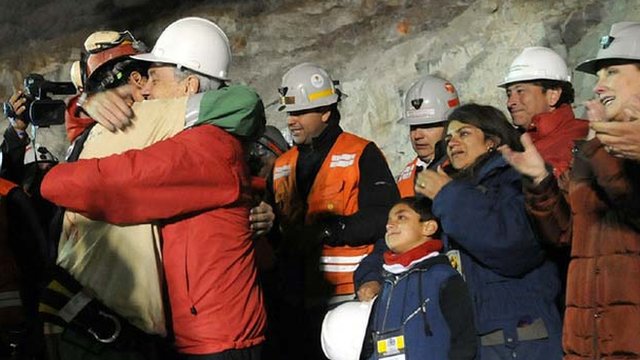 The first 17 of 33 miners trapped underground for more than two months in northern Chile have been winched to the surface amid scenes of jubilation.
The first 17 of 33 miners trapped underground for more than two months in northern Chile have been winched to the surface amid scenes of jubilation.
Florencio Avalos, the first to be released, was greeted by family and President Sebastian Pinera when he emerged at 0010 local time (0310 GMT).
All the freed miners are being taken to a triage centre for health checks.
The oldest of the 33, the youngest and the only non-Chilean are among those rescued to date.
The operation has run smoothly so far. Health Minister Jaime Manalich said that if working conditions stayed the same, the rescue should be completed in one-and-a-half days, half a day quicker than predicted.
The men have been trapped underground since 5 August, when a rockfall caused a tunnel to collapse.
'Gracias Chile!'
The rescue operation began shortly after 2315 local time (0215 GMT) with a technical expert, Manuel Gonzalez, being lowered down the 624m (2,047ft) rescue shaft.
Mr Gonzalez was then supposed to return to the surface.
However, a live video feed from the refuge where the miners were gathered showed Mr Avalos preparing to be winched up immediately.
A minute after the "Phoenix" capsule reached the top of the rescue shaft, Mr Avalos stepped out and was greeted by his family, rescuers and the president and the First Lady, Cecilia Morel.
Bystanders cheered and clapped, and then started chanting "Chile".
Mr Avalos gave a thumbs-up before being taken in an ambulance to a medical triage centre and then given time with his family.
The next to be freed were:
Mario Sepulveda, who brought a bag of stones from the mine as souvenirs; he ran towards a group of rescuers and led them in song
Juan Illanes, a former soldier who urged his fellow miners to be disciplined and organized while trapped
The only non-Chilean, Bolivian Carlos Mamani; Bolivian President Evo Morales spoke to Mr Mamani at the triage centre
Jimmy Sanchez, the youngest miner at 19; he had only been working at the mine for five months and had been showing signs of anxiety
Osman Araya, who had a hugely emotional reunion with his wife
Jose Ojeda, whose scribbled note - which read "All 33 of us are safe in the shelter" - informed the world the miners were still alive, 17 days after the rockfall that trapped them
Claudio Yanez, who was met by his partner of 11 years, Cristina Nunez; during the ordeal, they agreed to marry
Mario Gomez, at 63 the oldest miner, who sent up a letter shortly after the miners were found to be alive, expressing love for his family and saying that the mining company "has got to modernise"
Alex Vega, who was met by his wife Jessica Salgado, who said earlier that she had eased his fears over debts by telling him she had cleared them
Jorge Galleguillos, who said the journey to the surface was very smooth; "The only thing I wanted was to reach the top," he told President Pinera at the triage centre
Edison Pena, who became known as "the runner" because he ran up to 5km (3 miles) a day through the mine tunnels to keep himself fit, even in the 30-35C heat
Carlos Barrios, who reached the surface shortly before 1000 local time (1400 GMT)
Victor Zamora, not a miner but a driver who had gone underground to repair a vehicle and was trapped by the rockfall
Victor Segovia who was welcomed "back to life" by President Pinera
Daniel Herrera, who was embraced by his crying mother as he freed himself from the safety harness
Omar Reygadas, a bulldozer operator; after leaving the capsule, he knelt on the ground clutching a bible.
In his address, President Pinera thanked the technical experts who had made the rescue possible and said this was a night of emotion.
Recalling the devastating earthquake that struck Chile in February, he said the miners had shown that "when Chile is united, we are capable of doing great things".
"This country shows its true soul, shows what it is capable of, when we face adversity."
But the president added: "This won't be over until all 33 are out."
Mr Manalich said the health of the miners was "generally good".
Mario Sepulveda handed out stones to the rescue team on the surface
After their reunion with relatives, the miners are being flown by helicopter to hospital in the nearby city of Copiapo.
Outside the hospital, barriers have been set up to cope with the crowds of onlookers and journalists.
During their journey to the surface, the miners wear a "bio-harness" designed for astronauts, which monitors their heart rate, breathing, temperature and oxygen consumption. The rescue capsule is checked every eight ascents.
Officials said the first few men to be winched to the surface included some of the most psychologically stable and experienced of the miners, in case something went wrong.



